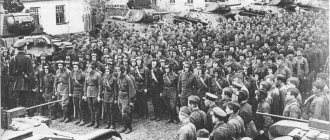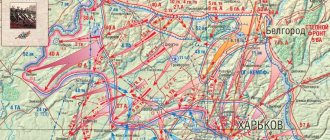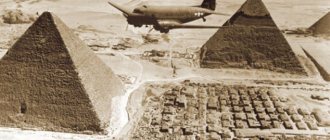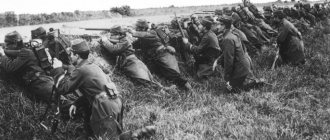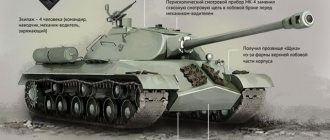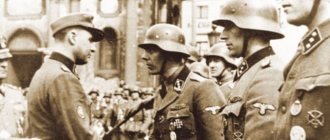| Operation Dragoon | ||
| Part of the Mediterranean Front - World War II | ||
| American soldiers land on the shores of France | ||
| date | August 1944 | |
| Place | south of France | |
| Coordinates | 43°13'37"N 6°39'42"E / 43.22708333, 6.66166667 | |
| Result | Allied victory | |
| Warring parties | ||
| Mediterranean Front Campaigns | |
|
Operation Anvil
(Anvil), later called
Dragoon
(Dragon) was executed on 15 August 1944, allowing the Allied landings in southeastern France, then occupied by Nazi Germany, between Toulon and Cannes during World War II.
This operation would allow the Allies to relieve pressure in Normandy, where the terrain was encountering heavy German resistance. In September 1944, the Allies participating in Operation Anvil-Dragoon succeeded in pushing the Germans north and contacting the Allies who had landed in Normandy. In addition, the Germans who occupied France were forced to retreat several kilometers from the French border with Germany, Luxembourg and Belgium.
Background
Map showing the Allied amphibious landings and advance into southern France, as well as German defensive positions.
During preliminary planning in early 1942, the operation was originally called Operation Anvil
"("Anvil") and was intended as an addition to Operation Sledgehammer ("Hammer"). The latter would involve crossing the English Channel from Great Britain to the north-west coast of France only in the event of the collapse of the USSR in the face of a German offensive in the spring of 1942.
After the danger of the collapse of the Soviet ally, the Americans and British decided to continue implementing Anvil's
and
Sledgehammer
, as they knew that in the future, final victory over Germany would involve landing on French soil.
Both operations were renamed "Dragoon" and "Overlord
" respectively.
Overlord
(main) envisioned an invasion of Normandy, while
Dragoon
was an addition intended to support General Eisenhower's right flank by landing troops on the Gallic Riviera.
British Prime Minister Winston S. Churchill argued that Operation Dragoon
" diverted military resources that could have been better used in invading the oil-producing areas of the Balkans, especially Romania, on which Germany depended for its defense and fuel supplies. Churchill also foresaw that the stationing of Western Allied troops in the area would mean a counterweight to the expansion of the Soviet zone of influence by Eastern European countries, a secondary benefit that Stalin hoped to gain from his fight to expel Nazi forces. from the depths of the USSR.
At worst, the British Prime Minister sought to obtain from President Franklin D. Roosevelt the necessary support so that, by sacrificing Dragoon
, order the Allied forces to make a final blow on the Italian front, which would sweep the Germans out of Rome and the Po Valley and, crossing the Alps, enter Vienna. This would put a saber on the back of German troops fighting the Red Army in Eastern Europe.
But the American military openly advocated a landing on the French Mediterranean coast. They hoped to create a united front in France after the Overlord's
and
Dragoons
, which was the fastest way to win the war in Europe.
As a secondary objective, but highly valued, the operation was to secure the ports of Toulon and Marseille, with which a new entry route could be opened for reinforcements and supplies with which the advance towards Germany could be supported. For their part, the British insisted that the troops already stationed in Italy should remain there in defiance of Dragoon.
. Churchill insisted on his refusal as he still believed in the invasion of Dalmatia and Istria, as he was haunted by the conviction that it was necessary to enter South-Eastern Europe before the arrival of Stalin's armies. This strategic disagreement was the first in importance among the Anglo-American allies.
The plan initially called for an invasion force consisting of Free French troops as well as Americans to take Toulon and then Marseille, although subsequent changes to the plan included Saint-Tropez among the targets. During the first half of 1944, and due to strategic and planning differences between the British General Staff, who continued to resist the landings, and the US Chiefs of Staff, the plan continued to undergo changes and delays.
The balance finally tilted towards Dragoon for two main reasons: the entry of Allied troops into Rome in early June, which partly dispelled Churchill's arguments for continuing to rely on the Italian campaign, and the success of Operation Cobra. in late July, the breakthrough of German positions from the Normandy beachhead opened the countryside of northwestern France to American armor. They, relying on the British position at Caen, were supposed to turn towards Paris, thus exposing their right flank. For all these reasons, it was finally decided that the D-Day of Operation Dragoon
"scheduled for August 15, 1944.
The Sixth United States Army Group, also called Army Group South or "Dragon Force", under the command of Lieutenant General Jacob L. Devers, was created in Corsica and activated on 1 August 1944 to unite the French and American forces he planned to invade. southern France in Operation Dragoon
".
At first, the 6th Army Group was subordinate to the Allied Headquarters under the command of General Sir Henry Maitland Wilson, who was the Supreme Commander of the Mediterranean Theater of Operations. But within a month of the Dragoon
Invasion, command of the 6th Army Group was transferred to the Supreme Commander, Supreme Headquarters Allied Expeditionary Force, or Supreme Headquarters Allied Expeditionary Force, under the command of General Dwight D. Eisenhower, Supreme Commander of the Allied Forces on the Western Front.
The Sixth Army Group consisted of the French 1st Army under General Jean de Lattre de Tassigny and the US 7th Army under Lieutenant General Alexander Patch. The divisions of the VI Army Corps (part of the 7th Army) would be responsible for forming the first waves of the invasion. Also in August 1944, the naval group Task Force 88 was activated, whose task was to conduct and support the Dragoon landings. In total, 450,000 Allied troops, 5,000 aircraft and 2,000 ships were assembled.
The south of France was occupied by the German Army Group G under the command of Colonel General Johannes Blaskowitz. The Army Group consisted of the 1st Army under General of the Infantry Friedrich Weise and the 19th Army under General Kurt von der Chevallery.
Resistance was not expected to be very strong, since the German 19th Army was forced to send all its mobile units to the Norman front and only one detachment remained between Perpignan and Nice. She had only half a dozen small Italian tanks, in addition to having to use a miscellaneous arsenal from the spoils of the 1940 war. Loire.
Campaign results
As a result, the only losses for the Dage were two killed and 25 wounded in battles with the 45th Iraqi Division. In total, during the Gulf War, the losses of the French contingent amounted to nine dead. Against the backdrop of the defeat of the 45th Motorized Rifle Division, this, of course, looks impressive. If we do not take into account the extremely low level of combat readiness of the Iraqi troops in this direction, which could not pose serious problems for the French units in overcoming the prepared defense.
The transience of the campaign and the weakness of the opposing forces did not allow the ground units to gain significant combat experience, and in general we can say that the French units reinforced by the Americans had to act in a secondary direction against the second-rate forces of the Iraqi army. However, the skills of the Daguet Division's participation in Operation Desert Storm were later used in the training programs of the French army. In addition, a significant part of the personnel received various state awards related to the operation.
Landings
The main striking force consisted of 3 American divisions (3rd, 36th and 45th Infantry Divisions) belonging to Lieutenant General Lucian Truscott's VI Army Corps, reinforced by the French 5th Armored Division. The 3rd Division captured the left flank of the landing area, code-named Alpha Beach, (in the town of Cavalier-sur-Mer), the 45th stormed the center, Delta Beach (in Saint-Tropez) and the 36th landed on the right, on Camel beach (Saint Raphael).
Simultaneously with and in support of these main landings, other secondary operations were carried out on both flanks of the main invasion axis. At Cape Negro, on the western flank, a large group of French commandos destroyed German artillery positions in Operation Romeo.
From the air, the 1st Airborne Task Force carried out a parachute landing beyond the landing beaches, in the Le Muy-Le Luc area, which was given the name Operation Dove. This force, also known as the Rugby Force, consisted of the British 2nd Independent Parachute Brigade, the US 517th Regimental Parachute Combat Team and a combined glider and parachute regimental combat team of the 509th Parachute Infantry Battalion, 550th Airborne infantry regiment. Glider Battalion and 1st Battalion, 551st Parachute Infantry Regiment, all units owned by the US Army. Participating in the airborne invasion was the 887th Airborne Engineer Company, which had the distinction of being the only engineer unit in the entire European theater capable of carrying out the mission for which it was trained, that is, carrying out its own mission as an engineer unit after a combat landing from gliders. In total, about two thousand allied paratroopers took part in “Golub”.
The 1st Special Forces Detachment conducted Operation Sitka, during which it captured two offshore islands to protect a beachhead. Intelligence agencies planned and executed Operation Overflight before the invasion to disguise the main attack and mislead the German Nineteenth Army, which was responsible for the defense of the area, about the true Allied intentions. Also during the operation, dolls were dropped by parachute at night to mislead the German defenders. Allied agents convinced Russian auxiliaries serving with the German forces to desert in exchange for immunity.
Naval support fire provided by Allied ships included fire from the French battleship Lorraine, the British battleship HMS Ramillies
and the American battleships USS
Texas
, USS
Nevada
and USS
Arkansas
. In addition, the landing was supported by a fleet of 50 cruisers and destroyers.
Aircraft from 7 Allied escort carriers, along with fighters based in Corsica, provided air cover. On the first day, approximately 94,000 troops and 11,000 pieces of equipment were landed. Some of the German troops that were to face them were sent to fight the Allied "Overlord" forces in northern France. Also, a major attack by French Resistance irregulars, coordinated by Captain Aaron Banke of the OSS (Office of Strategic Services), the predecessor of the CIA, helped delay and entertain the remaining German forces in the beachhead area in advance of the landings. As a result, the Allied forces encountered little resistance as they began to advance inland. The rapid success of the invasion, penetrating some 24 kilometers in the first 24 hours, sparked a large uprising of the resistance in Paris.
The landings were carried out by the headquarters of the VI Army Corps and the headquarters of the 7th Army, as well as the French Army B (later renamed the 1st Army), consisting of the French I and II Army Corps. The U.S. Army's 51st Evacuation Hospital landed to treat the wounded.
Tasks set by the command of the operation
As part of the operation plan, the Dage Division was tasked with supporting the western side of the coalition forces, which carried out the main attack through the desert west of Kuwait. The unit's flank was adjacent to the battle formations of the 101st Airborne Division of the US Army, which was developing an offensive towards the Euphrates on a parallel course. To ensure cooperation, directly adjacent to the flank of the 101st Division were units of the 2nd Brigade of the 82nd Division, included in the "Dage". Thus, French troops operated in the westernmost part of the entire offensive zone of the coalition forces.
To accomplish this task, the French had to capture the airfield and the Al-Salman crossroads, and then advance to the Euphrates, supporting the flank of the 101st US Airborne Division. “Daga” was opposed by the 45th motorized rifle division of the Iraqi army, part of the 9th corps, which covered the Al-Salman airbase, being deployed 70-80 kilometers from the border with Saudi Arabia. Iraqi units in this direction did not have enough heavy weapons and a limited amount of artillery. In addition, the French and Americans were able to achieve the effect of tactical surprise here.
Consequences
The quick withdrawal of the German 19th Army ensured an easy victory for the Allied forces, who suffered few casualties during and after the landings. But paradoxically, this fact was a posteriori an obstacle for the Allies. The plans envisaged greater resistance near the landing zones and, therefore, they underestimated the need for wheeled transport that would arise in the early moments of the invasion. But given the ease and speed with which they were able to land large quantities of equipment, the subsequent need for fuel exceeded the supply capacity of the Allied rear units. This shortage presented a greater obstacle to advance than the resistance of the Teutonic forces. As a result, several German formations withdrew into the Vosges region and into Germany.
Two days after the landings, the offensive took two directions: the French 2nd Corps attacked Toulon and Marseille, while the Americans advanced to the lower Durance with the clear intention of closing the Rhône valley at Avranges. Under these conditions, the Germans had to retreat to the Rhone and Saone valleys.
The fighting on the coast ended on August 27. Toulon, Marseille, Cannes and Nice were occupied and the Italian border was reached. The Seventh Army took more than 250,000 prisoners. Finally, in mid-September, the Dragon Force linked up with the southern wing of George Patton's Third Army, advancing from Operation Overlord near Dijon.
After the battle, the Allies were faced with the problem that neither the port of Toulon nor the port of Marseille could be used at the moment. Toulon was a pile of ruins, and in Marseille, the German admiral Heinrich Rufus blew up 9,000 meters of docks, destroyed 200 cranes and sank 70 ships. In addition, both cities suffered severe damage due to the premature actions of the French resistance movement.
The rapid advance following Cobra (the Allied operation that broke through the Normandy front) and Dragoon slowed almost to a halt in September 1944 due to severe shortages of supplies. But as damage to the Marseille port and railway lines began to be repaired, an important supply route opened up for the advance into Germany through southern France. Thousands of tons of supplies landed at French Mediterranean ports, obtained thanks to Dragoon, were sent to northwestern France to compensate for the inadequate port facilities of Brittany and Normandy, providing a third of the needs of the Allied forces.
Sources
- Clark and Smith (1993), para. 92.
- Tucker-Jones (2010), para. 92.
- Clark and Smith (1993), para. 42.
- ^ a b
Clark and Smith (1993), para. 70. - ^ a b
Clodfelter 2022, paragraph 474 - "Statistical and Accounting Department of the Adjutant General" p. 93
- “Statistical and accounting department of the adjutant general” paragraph 93
- Clark and Smith (1993), para. 195.
- ^ a b
Vogel (1983), pp. 604–605. - Stock (2009), para. 88.
- Clark and Smith (1993), para. 197.
external reference
- US Army Campaigns during World War II - Southern France (in English)
- [1] (broken link available at the Internet Archive; see , and version).
| Control of authorities |
|
- Data: Q221111
- Multimedia: Operation Dragoon
